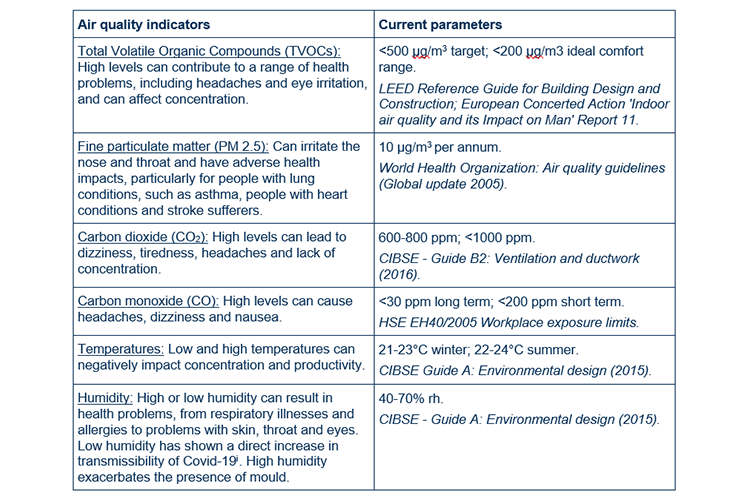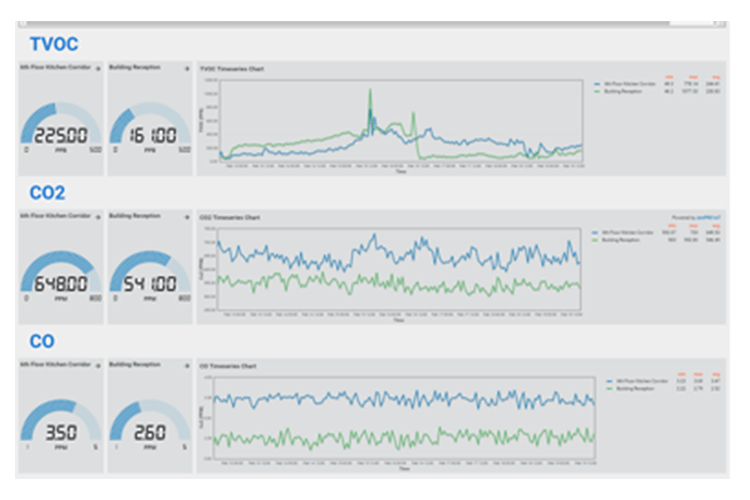Tandem Rolls Out Live Air Quality Monitoring Service
03 June 2021Tandem Rolls Out Live Air Quality Monitoring Service
03 June 2021As part of a wider programme to enhance occupier wellbeing and productivity, and reassure people returning to offices post-Covid, Tandem Property Asset Management has introduced a live indoor air quality monitoring service. Delivered in collaboration with facilities management partner Envirotech, this is empowering facilities teams to take action to improve performance. Successfully piloted in three buildings, it will be rolled out across multiple buildings throughout the rest of 2021.
Key Facts
- Live air quality sensors providing real time data
- Improving wellbeing and productivity
- Boosting confidence in offices post-Covid
Situation
Tandem is an independent property asset management partnership. Their team of professionals has over 250 years of combined experience across the property sector, which they draw on to provide services that add value for clients and occupiers.
Working with facilities management partner Envirotech, Tandem introduced live indoor air quality monitoring in three buildings in 2020, including its own head office, with wider rollout underway.
Drivers for this joint initiative included adding value for:
- Occupiers: Improved air quality contributes to wellbeing and productivity. Occupiers are also asking more questions about air quality, as they seek reassurance returning to their offices post-Covid. With good ventilation reducing the risk of virus transmission, the live monitoring service gives occupiers greater confidence that air quality is managed to high standards.
- Clients: Enhanced health and wellbeing credentials can be a differentiator when letting space, boosting market appeal and protecting asset value over the long term. Clients are also increasingly interested in air quality data for Fitwel, RESET and WELL Building Standard certifications and GRESB reporting.
Longer term, Tandem believes live air quality monitoring will become business as usual in all managed properties.
Actions
Envirotech’s technical experts install discrete sensors in key locations in each building and connect them to a micro gateway, also positioned on site. All sensors operate to globally accepted standards. The gateway securely transfers live air quality data to a dashboard, which links into the building’s facilities management CAFM system.
The dashboard monitors air quality indicators against agreed parameters, set based on the latest guidance. When levels exceed these parameters, an alert is raised on the dashboard and sent to the CAFM system to create an action for the facilities manager to deal with. Where clients or occupiers are interested in wellness certifications, such as RESET and WELL, parameters can be adjusted in line with their specific requirements.
Figure 1: Air quality indicators and parameters
Sensors and Gateways
Devices:
- Mains powered sensors: Monitor TVOCs, PM2.5, CO2, CO, temperatures and humidity. The sensors also have wider capabilities, which Tandem is looking at for the future.
- Battery powered sensors: Monitor humidity and temperatures.
- Mains powered micro gateways: These have a SIM card and monthly data plan, using a low powered wide area network standard (LoRaWAN) to connect to sensors, and using a GSM or LAN connection to transmit data to the operating system based in the cloud. They require no interaction with Wi-Fi or corporate networks.
Figure 3: Sample dashboard
Envirotech provides a monthly data analysis report that interprets data and highlights improvement opportunities, particularly where there are repeated alerts in an area:
In one building, high levels of CO2 at certain times resulted in changes to the operating hours for the heating, ventilation and air conditioning (HVAC) system, to introduce greater levels of fresh air at those times.
In another building, high readings in the reception area led to the installation of air purifying equipment, as the issue was unlikely to change, due to its location.
Financial
The initial set up costs to purchase and install the equipment are funded by the property owner. Ongoing maintenance and management are funded by occupiers through their service charge. Costs vary according to the space to be covered and number of sensors required.
Sensor technology has improved significantly in the past two years and costs have come down. Two years ago, it was expensive to get point-in-time air quality readings. Now, live air quality data can be gathered via discrete, relatively low-cost sensors.
Benefits
- Occupiers: Improved air quality, which can contribute to employee wellbeing, leading to fewer sick days and higher productivity. Proactive air quality management is also reassuring for people returning to offices post-Covid. Tandem will ask occupiers for feedback at quarterly occupier meetings. For more on how Tandem plans to engage with occupiers on air quality, see the section on occupiers below.
- Clients: Enhanced building performance, which over the long-term can help attract occupiers and maintain asset value. Access to live air quality data also supports clients seeking Fitwel, RESET and WELL Building Standard certifications and GRESB reporting.
- Tandem: Real-time insights to optimise building performance, enhancing Tandem’s reputation for realising client aspirations and delivering comfortable, productive environments for occupiers. It also provides a new platform for engagement with occupiers and clients.
Challenges and Achievements
OCCUPIERS
How to engage with occupiers on air quality?
Initially intended only for common areas, Tandem has also introduced sensors in occupier areas, due to interest from both occupiers and clients. As more people return to offices post-Covid, property managers will engage with occupiers on air quality performance through meetings. Tandem is also exploring opportunities to expand access to live air quality dashboards to occupiers, both online and via screens in each building. The challenge is presenting the data in a format that is easily understandable and meaningful, as it currently requires a level of technical knowledge. Tandem has already started using its head office as a test bed for this, presenting air quality data on a tablet in reception, with team members on hand to interpret and explain what the data shows.
SENSORS
How to introduce sensor technology?
The number of sensors required depends on floor area and ceiling heights. The density of sensors also varies across different certification schemes. A level of technical experience is needed to position sensors correctly, so they are in locations reflective of the space where people are spending time. Otherwise, it can significantly impact data quality. For instance, sensors are better placed at head height (where people breathe in air), rather than on the floor. It is also better to position sensors close to workspaces and reception desks (where people spend time), rather than next to a door that is constantly opening and closing. In Tandem’s three pilot buildings, the Envirotech team positioned 21 sensors in key locations across 10,641m2. The challenge now is installing sensors fast enough to meet the high demand as occupiers prepare to return to their offices! Once installed, the sensors can provide live monitoring within 24 hours.
*Please note that the information on this page was supplied by the BBP Member and the BBP assumes no responsibility or liability for any errors or omissions in the content


